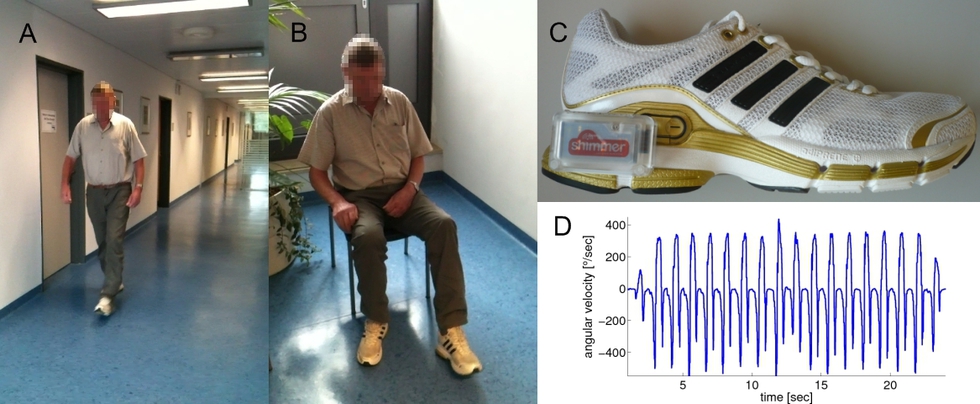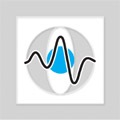-
Parkinson`s disease (PD) is a chronic disorder of the central nervous system, characterized by degeneration of dopaminergic neurons leading to progressive gait dysfunction. To maintain patient’s quality of life, objective classification of gait symptoms in PD is crucial to adequately manage the individual treatment. We will establish a sensor based biometric gait-analysis that enables reproducible, objective, rater-independent assessment of gait symptoms. With a therapist independent rating completely comparable results can be reached. Different sensors (gyroscopes, accelerometers, in-sole pressure sensors,...) attached to a comfortable sport shoe detected motion signals assessed during standardized exercises while the subject is walking or sitting on a chair. Using pattern recognition methods, signal features should be analyzed from PD patients and healthy controls. Classification between patients and controls and a identification of different PD stages should be done. A pilot study suggests that biometric gait-analysis may be an important and complementary mean to support disease management in PD. Future biometric studies will help to monitor the disease course, to modify and adjust treatment thus rationalizing therapeutic decisions. To differentiate between PD specific and age dependent gait disorders also data from subjects in different decades of life should be analyzed.
This project is a close cooperation between
the Pattern Recognition Lab,
the
 Department for Molecular Neurology of the University Hospital in Erlangen and
Department for Molecular Neurology of the University Hospital in Erlangen and the company
 ASTRUM IT GmbH.
ASTRUM IT GmbH.
Picture A and B shows a patient while he is doing standardized exercises for recording motion signals. In A he is walks in a comfortable speed and in B he is doing a Heel-Toe-Tapping exercise. The sensor setup is shown in figure C, which is a sport shoe with attached inertial sensors. A typical gait signal of the gyroscope in the sagittal plane is shown in picture D.  Articles in Conference ProceedingsWearable Static Posturography Solution Using a Novel Pressure Sensor SoleEngineering in Medicine and Biology Society (EMBC), 2014 36th Annual International Conference of the IEEE (36th Annual International Conference of the IEEE EMBS), Chicago, Illinois, USA, August 26-30, 2014, pp. 2973-2976, 2014 (BiBTeX, Who cited this?)Journal ArticlesBiosensorische Bewegungserfassung beim Parkinson-SyndromNeurologie & Rehabilitation, vol. 19, pp. 69-76, 2013 (BiBTeX, Who cited this?)PLoS ONE, vol. 8, no. 2, pp. e56956, 2013 (BiBTeX, Who cited this?)Automated gait analysis in Parkinson's diseaseBasal Ganglia, vol. 3, no. 1, pp. 61, 2013 (BiBTeX, Who cited this?)Individualized rating of motor impairment using sensor-based gait analysis in Parkinson's disease by multiparametric regressionBasal Ganglia, vol. 3, no. 1, pp. 52-53, 2013 (BiBTeX, Who cited this?)Articles in Conference ProceedingsSubsequence dynamic time warping as a method for robust step segmentation using gyroscope signals of daily life activitiesEngineering in Medicine and Biology Society (EMBC), 2013 35th Annual International Conference of the IEEE (35th Annual International Conference of the IEEE EMBS), Osaka, Japan, July 3-7, 2013, pp. 6744-6747, 2013 (BiBTeX, Who cited this?)BSA Conference 2013 - Biosignal Analysis, Rio de Janeiro, Brazil, 21.10.2013-24.10.2013, pp. 1-4, 2013 (BiBTeX, Who cited this?)Combined analysis of sensor data from hand and gait motor function improves automatic recognition of Parkinson's diseaseEngineering in Medicine and Biology Society (EMBC), 2012 Annual International Conference of the IEEE (EMBC), San Diego CA, USA, Aug. 28 2012-Sept. 1 2012, pp. 5122-5125, 2012 (BiBTeX, Who cited this?)Journal ArticlesMobile biometrische GanganalyseDer Nervenarzt 2011, no. 12, pp. 1604-1611, 2011 (BiBTeX, Who cited this?)Articles in Conference ProceedingsBiometric and Mobile Gait Analysis for Early Detection and Therapy Monitoring in Parkinson's DiseaseEngineering in Medicine and Biology Society,EMBC, 2011 Annual International Conference of the IEEE (33rd Annual International Conference of the IEEE EMBS), Boston, USA, August 30 - September 3, 2011, pp. 868-871, 2011 (BiBTeX, Who cited this?)
Articles in Conference ProceedingsWearable Static Posturography Solution Using a Novel Pressure Sensor SoleEngineering in Medicine and Biology Society (EMBC), 2014 36th Annual International Conference of the IEEE (36th Annual International Conference of the IEEE EMBS), Chicago, Illinois, USA, August 26-30, 2014, pp. 2973-2976, 2014 (BiBTeX, Who cited this?)Journal ArticlesBiosensorische Bewegungserfassung beim Parkinson-SyndromNeurologie & Rehabilitation, vol. 19, pp. 69-76, 2013 (BiBTeX, Who cited this?)PLoS ONE, vol. 8, no. 2, pp. e56956, 2013 (BiBTeX, Who cited this?)Automated gait analysis in Parkinson's diseaseBasal Ganglia, vol. 3, no. 1, pp. 61, 2013 (BiBTeX, Who cited this?)Individualized rating of motor impairment using sensor-based gait analysis in Parkinson's disease by multiparametric regressionBasal Ganglia, vol. 3, no. 1, pp. 52-53, 2013 (BiBTeX, Who cited this?)Articles in Conference ProceedingsSubsequence dynamic time warping as a method for robust step segmentation using gyroscope signals of daily life activitiesEngineering in Medicine and Biology Society (EMBC), 2013 35th Annual International Conference of the IEEE (35th Annual International Conference of the IEEE EMBS), Osaka, Japan, July 3-7, 2013, pp. 6744-6747, 2013 (BiBTeX, Who cited this?)BSA Conference 2013 - Biosignal Analysis, Rio de Janeiro, Brazil, 21.10.2013-24.10.2013, pp. 1-4, 2013 (BiBTeX, Who cited this?)Combined analysis of sensor data from hand and gait motor function improves automatic recognition of Parkinson's diseaseEngineering in Medicine and Biology Society (EMBC), 2012 Annual International Conference of the IEEE (EMBC), San Diego CA, USA, Aug. 28 2012-Sept. 1 2012, pp. 5122-5125, 2012 (BiBTeX, Who cited this?)Journal ArticlesMobile biometrische GanganalyseDer Nervenarzt 2011, no. 12, pp. 1604-1611, 2011 (BiBTeX, Who cited this?)Articles in Conference ProceedingsBiometric and Mobile Gait Analysis for Early Detection and Therapy Monitoring in Parkinson's DiseaseEngineering in Medicine and Biology Society,EMBC, 2011 Annual International Conference of the IEEE (33rd Annual International Conference of the IEEE EMBS), Boston, USA, August 30 - September 3, 2011, pp. 868-871, 2011 (BiBTeX, Who cited this?)

